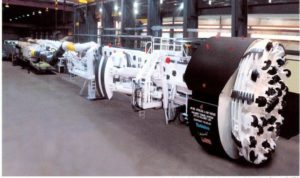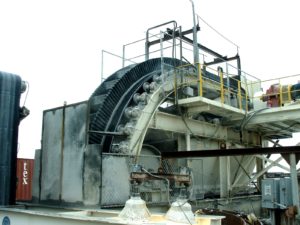![65 Years of Innovation and Experience [default]](https://www.robbinstbm.com/wp-content/uploads/2017/04/Side-Bar-Blue-Blocks_70-Years.jpg)
A Solution for Every Condition: Search our Project Database
Project Map
FEATURED PRODUCT: CROSSOVER MACHINES
Our History
A Legacy of Innovation
Information 24/7
News & Media
Insights in the Industry:
Read the Robbins Blog
 The Little Calumet Leg Tunnel is the final element in Phase 1 of Chicago’s long-running Tunnel and Reservoir Project (TARP). The project involves storm water storage, reservoirs, and feeder tunnels that have greatly improved water quality in Chicago-area Rivers. The Little Calumet Leg is part of a longer TARP tunnel system that prevents combined sewer overflows from spilling into the Little Calumet River.
The Little Calumet Leg Tunnel is the final element in Phase 1 of Chicago’s long-running Tunnel and Reservoir Project (TARP). The project involves storm water storage, reservoirs, and feeder tunnels that have greatly improved water quality in Chicago-area Rivers. The Little Calumet Leg is part of a longer TARP tunnel system that prevents combined sewer overflows from spilling into the Little Calumet River.
In 2002, the project owner, Metropolitan Water Reclamation District of Greater Chicago (MWRDGC), awarded the construction contract to the Jay Dee/Affholder Joint Venture. The two contractors split the work, with Jay Dee responsible for surface works, shallow tunnels, and shafts. Affholder was responsible for deep tunnels and TBM boring. The joint venture chose a 5.56 m (18.2 ft) diameter Robbins Main Beam TBM to bore a 12.8 km (8.0 mi) section of tunnel.
The rock consisted of Silurian age dolomitic limestone with an Unconfined Compressive Strength (UCS) of 97 – 241 MPa (14 – 35 ksi). The limestone had few faults and was considered good tunneling ground.
Robbins refurbished the Main Beam TBM specifically for the project. The machine featured 39 wedge lock 19 inch (483 mm) cutters and a cutterhead thrust of 9,101 kN (2,044,050 lb). The cutterhead was driven by seven 335.6 kW (450 hp) AC electric motors that supplied 2,350 kW (2,975 hp) of power to the cutterhead. The machine also generated 1,882,877 N-m (1,389,705 lb-ft) of cutterhead torque.
Muck was transported by a Robbins conveyor system, including an an advancing horizontal conveyor, S-type vertical conveyor, surface conveyor, and stacker conveyor.The muck was transported from the bridge conveyor on the back-up to the main horizontal conveyor. A conveyor with self-adjusting curve idlers was necessary for most of the tunnel in order to negotiate tight curves.
 Excavation of the tunnel began on February 13, 2003. The tunnel was driven in two sections from a central launch shaft with an initial bore of 6.1 km (3.8 mi). After the initial drive, the head cutterhead support were hoisted out of the reception shaft. The rest of the machine was then reunited with the head and cutterhead support and taken back through the tunnel for the second 6.7 km (4.1 mi) drive.
Excavation of the tunnel began on February 13, 2003. The tunnel was driven in two sections from a central launch shaft with an initial bore of 6.1 km (3.8 mi). After the initial drive, the head cutterhead support were hoisted out of the reception shaft. The rest of the machine was then reunited with the head and cutterhead support and taken back through the tunnel for the second 6.7 km (4.1 mi) drive.
The machine executed both drives flawlessly. The TBM broke the world record for best advance in a single eight-hour shift at 45.75 m (150.1 ft), best advance in a day at 116.7 m (382.9 ft), and best advance in a week at 474.7 m (1,557 ft). It also broke the record for most rock excavated in 24 hours at 2,836.55 cu m (3,710 cu yd). The TBM holed through in February 2004.

 Close
Close